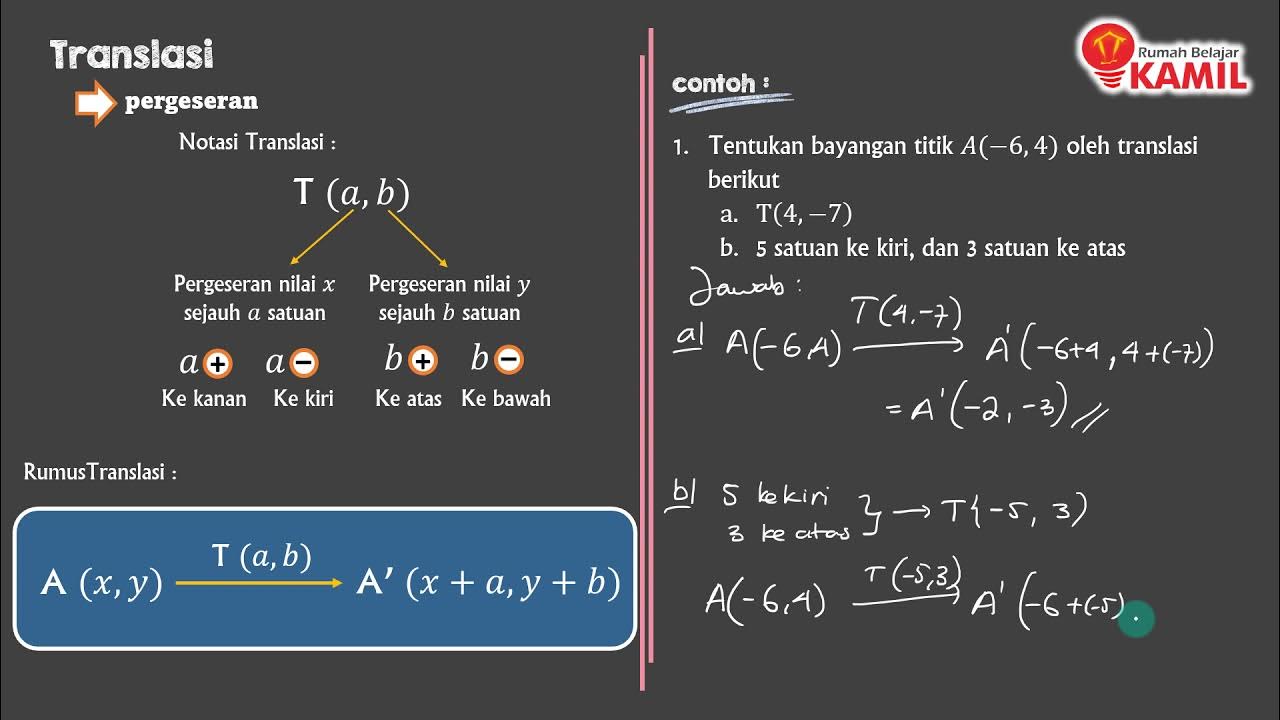Transformasi Geometri Bagian 3 - Rotasi (Putaran) Matematika Wajib Kelas 11
Summary
TLDRIn this educational video, Handayani introduces the concept of geometric transformations, focusing specifically on rotation. The video explains how to rotate points around the origin (0,0) and other centers using rotation matrices. Through clear examples, such as rotating points by 90° and 180°, viewers learn to calculate new coordinates using trigonometric functions. The tutorial also covers composition of rotations and the process of rotating lines, providing comprehensive insights into geometric transformations. Handayani emphasizes the importance of understanding matrix multiplication and trigonometric principles, making the content accessible for learners at various levels.
Takeaways
- 😀 The video discusses geometric transformations, specifically focusing on rotation as the third part of the series.
- 😀 Rotation is explained as the movement of a point around a center point, which is commonly the origin (0,0).
- 😀 The formula for finding the coordinates after rotation is presented, using rotation matrices with angles measured in degrees.
- 😀 An example illustrates how to find the coordinates of a point after a 90° rotation around the origin, demonstrating the use of trigonometric functions.
- 😀 For clockwise rotations, the angle is treated as negative, while counterclockwise rotations are positive.
- 😀 The importance of understanding special angles in trigonometry (like 90° and 180°) is emphasized for accurate calculations.
- 😀 The video also covers how to rotate points around a different center, introducing a modified formula that accounts for the new center coordinates.
- 😀 A second example showcases rotating a point by 180° clockwise, reinforcing the use of the rotation matrix.
- 😀 The concept of composition of rotations is introduced, allowing for the simplification of multiple rotations into a single calculation.
- 😀 The final part of the video discusses rotating lines or curves and provides a systematic approach to derive the new equation after rotation.
Q & A
What is the main topic of the video?
-The main topic of the video is the geometric transformation known as rotation.
What geometric transformations were discussed prior to rotation?
-The video discusses translation and reflection as the previous geometric transformations.
How is rotation defined in this context?
-Rotation is defined as turning a point around a center point, specifically around the origin (0,0) in the examples provided.
What is the formula for calculating the coordinates of a point after rotation?
-The formula for rotation is expressed in matrix form: X' = cos(α) * X - sin(α) * Y and Y' = sin(α) * X + cos(α) * Y, where α is the rotation angle.
What are the steps to rotate a point 90 degrees around the origin?
-To rotate a point 90 degrees around the origin, substitute α = 90° into the rotation formulas, resulting in X' = -Y and Y' = X.
How does the direction of rotation affect the angle used?
-For counterclockwise rotation, the angle is considered positive, while for clockwise rotation, the angle is negative.
What adjustment must be made when rotating a point around a different center other than the origin?
-When rotating around a different center point (P, Q), you need to adjust the coordinates by subtracting the coordinates of the center point before applying the rotation formula.
What is the significance of the coordinates being negative during rotation?
-Negative coordinates indicate a shift in the direction of rotation, especially when using negative angles or rotating clockwise.
Can multiple rotations be combined, and if so, how?
-Yes, multiple rotations can be combined by adding their angles together and applying the rotation formula in a single calculation.
What is the outcome of rotating a line equation, such as 4X - 2Y = 3?
-The outcome involves transforming the line equation using the rotation formulas to express the new line after the specified rotation around a given center.
Outlines

Esta sección está disponible solo para usuarios con suscripción. Por favor, mejora tu plan para acceder a esta parte.
Mejorar ahoraMindmap

Esta sección está disponible solo para usuarios con suscripción. Por favor, mejora tu plan para acceder a esta parte.
Mejorar ahoraKeywords

Esta sección está disponible solo para usuarios con suscripción. Por favor, mejora tu plan para acceder a esta parte.
Mejorar ahoraHighlights

Esta sección está disponible solo para usuarios con suscripción. Por favor, mejora tu plan para acceder a esta parte.
Mejorar ahoraTranscripts

Esta sección está disponible solo para usuarios con suscripción. Por favor, mejora tu plan para acceder a esta parte.
Mejorar ahora5.0 / 5 (0 votes)






